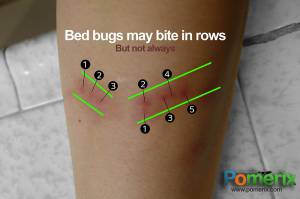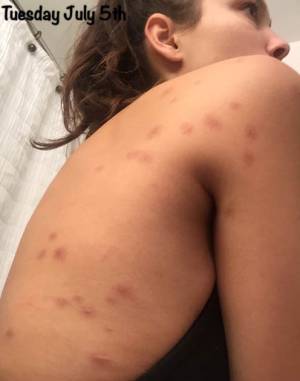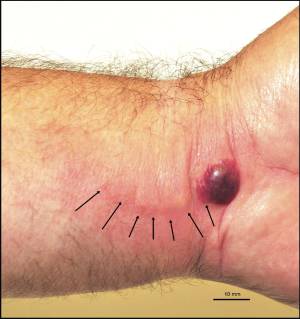Bed Bug Bite Identification And Differentiation
|
|
Pomerix staff
Published: 2020-10-04
|
Bed bugs infestations were common in the United States before World War II, but wide-scale usage of DDT caused these pests to disappear from many areas of the world. In recent years, however, due to the international travels and the ban on DDT, they have made a comeback into the U.S homes, apartments, hotels, dormitories, shelters, and public transportation systems.
Bed bugs are small, brownish, and flattened insects. Adult bed bugs are oval and about 3/16 inches (4-7 mm) long. They are equipped with piercing-sucking mouthparts and feed solely on human blood. During the day, they tend to hide in bedding, mattresses, behind baseboards, and other furnishings, and at night, they attack their victims asleep in their beds or even on a couch. They usually feed on the upper body of humans, where the skin is exposed. They also have a “musty-sweetish” smell that sometimes is felt around the place.
Bed bugs feed exclusively on human blood and may cause anxiety, sleep disruption, and mild to severe skin reactions. Consequently, individuals who experience itchy and raised skin usually think about bed bugs as the culprit. Unfortunately, identifying bed bugs based on skin symptoms is not as easy as it sounds. Nevertheless, several signs can help us identify bed bug bites or at least help us rule out other biting arthropods to a degree.
Signs and Symptoms
In general, skin reactions to bed bugs can vary significantly from person to person. Still, usually, the typical bite size is around 1/16 to 25/32 inch (2-20 mm) wide, itchy, red, flat, or raised welt, with a central bleeding point. They also vary in number and distribution but may appear in a row or a cluster and occur primarily on exposed upper body areas (face, neck, shoulders, arms, and hands). The bites may also cause several systemic reactions such as asthma, edema, iron deficiency anemia, and in very rare cases, anaphylactic shocks. Therefore, you must avoid scratching the bites to prevent infections.
Do bed bug bites change in color or shape over time?
The answer is Yes. Bed bug bites start with red, itchy macules (discolored area) with a central hemorrhagic point, occurring in rows or clusters (not always in rows or clusters). Later, they will usually turn into wheals, papules, vesicles, and less commonly, they may transform into fluid-filled lesions or even secondary infections.
Difference between bed bug bites and those of other arthropodsBed bug bites can easily be mistaken with flea, mosquito, louse, or spider bites. Bear in mind that most arthropod bites cause raised itchy skin. The following list is a comparison between bed bug bites and those of other common arthropods:
- Bed bug bites may appear in rows or clusters in unclothed areas of the body, while flea bites usually occur in irregular groups. Also, bed bugs cause simple flat or raised lesions in unclothed areas, while fleas cause red wheals with hemorrhagic center points in areas with loose clothing.
- Bed bug bites cause itchy red spots (flat or raised), while lice cause skin wear-offs.
- Bed bug bites may appear in rows or clusters of red lesions while mosquito bites are scattered, pale, itchy wheals.
- Bed bug bites are common in unclothed areas, while scabies mite tunnels are itchy vesicles that are primarily found in skin folds.
- Bed bugs cause linear or grouped red lesions while spiders cause single lesions, usually in areas with thinner skinned areas.
- Bed bug bites are itchy and appear in unclothed skin, while tick bites are painless and red primarily in protected parts of the skin.
Figure 3: An extreme case of reaction to bed bug bites
For more detailed information on different bite symptoms, please refer to table 1.
Table 1. Differential Diagnosis of Bed bug Bites (Studdiford et al. 2012)
|
Pest |
Clinical characteristics of typical bite |
|
Bed bugs |
Itchy flat and raised skin in clusters or lines in unclothed areas |
|
Fleas |
Irregular groups of red wheals with a central hemorrhagic point under loose areas of clothing, (e.g., lower legs, waist) |
|
Lice |
Wear-offs, identified by examining clothing seams and hair for lice and nits |
|
Mosquitoes |
Soft, pale, itchy wheals scattered in unclothed areas |
|
Scabies mite |
Itchy skin tunnels or vesicles in skin folds and regions under tight clothing |
|
Spiders |
Single injury in an area where clothing binds tightly; thin areas of skin are more likely to be bitten |
|
Ticks |
Painless red raised rash with or without itch, usually discovered in protected sites (e.g., skin folds or hair-covered regions) during the spring and summer |


